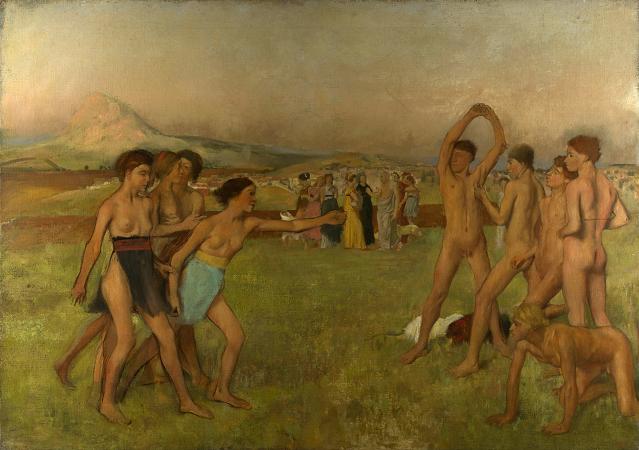Edgar Degas (1834 - 1917). Edgar Degas was a French artist famous for his paintings, sculptures, prints, and drawings. He is especially identified with the subject of dance; more than half of his works depict dancers. Regarded as one of the founders of Impressionism, he rejected the term, preferring to be called a realist. He was a superb draftsman, and particularly masterly in depicting movement, as can be seen in his rendition of dancers, racecourse subjects and female nudes. His portraits are notable for their psychological complexity and for their portrayal of human isolation. At the beginning of his career, Degas wanted to be a history painter, a calling for which he was well prepared by his rigorous academic training and close study of classical art. In his early thirties, he changed course, and by bringing the traditional methods of a history painter to bear on contemporary subject matter, he became a classical painter of modern life. Degas was born in Paris, France, into a moderately wealthy family. He was the oldest of five children of Celestine Musson De Gas, a Creole from New Orleans, Louisiana, and Augustin De Gas, a banker. His maternal grandfather Germain Musson, was born in Port-au-Prince, Haiti of French descent and had settled in New Orleans in 1810. Degas began his schooling at age eleven, enrolling in the Lycee Louis-le-Grand. His mother died when he was thirteen, and the main influences on him for the remainder of his youth were his father and several unmarried uncles. Degas began to paint early in life. By the time he graduated from the Lycee with a baccalaureat in literature in 1853, at age 18, he had turned a room in his home into an artist's studio. Upon graduating, he registered as a copyist in The Louvre Museum, but his father expected him to go to law school. Degas duly enrolled at the Faculty of Law of the University of Paris in November 1853, but applied little effort to his studies. In 1855 he met Jean-Auguste-Dominique Ingres, whom Degas revered and whose advice he never forgot: Draw lines, young man, and still more lines, both from life and from memory, and you will become a good artist. In April of that year Degas was admitted to the Ecole des Beaux-Arts. He studied drawing there with Louis Lamothe, under whose guidance he flourished, following the style of Ingres. In July 1856, Degas traveled to Italy, where he would remain for the next three years. In 1858, while staying with his aunt's family in Naples, he made the first studies for his early masterpiece The Bellelli Family. He also drew and painted numerous copies of works by Michelangelo, Raphael, Titian, and other Renaissance artists, but, contrary to conventional practice, he usually selected from an altarpiece a detail that had caught his attention: a secondary figure, or a head which he treated as a portrait. Upon his return to France in 1859, Degas moved into a Paris studio large enough to permit him to begin painting The Bellelli Family, an imposing canvas he intended for exhibition in the Salon, although it remained unfinished until 1867. He also began work on several history paintings: Alexander and Bucephalus and The Daughter of Jephthah in 1859-60; Semiramis Building Babylon in 1860; and Young Spartans around 1860. In 1861 Degas visited his childhood friend Paul Valpineon in Normandy, and made the earliest of his many studies of horses. He exhibited at the Salon for the first time in 1865, when the jury accepted his painting Scene of War in the Middle Ages, which attracted little attention. Although he exhibited annually in the Salon during the next five years, he submitted no more history paintings, and his Steeplechase, The Fallen Jockey signaled his growing commitment to contemporary subject matter. The change in his art was influenced primarily by the example of Edouard Manet, whom Degas had met in 1864. Upon the outbreak of the Franco-Prussian War in 1870, Degas enlisted in the National Guard, where his defense of Paris left him little time for painting. During rifle training his eyesight was found to be defective, and for the rest of his life his eye problems were a constant worry to him. After the war, Degas began in 1872 an extended stay in New Orleans, Louisiana, where his brother Rene and a number of other relatives lived. Staying at the home of his Creole uncle, Michel Musson, on Esplanade Avenue, Degas produced a number of works, many depicting family members. One of Degas's New Orleans works, A Cotton Office in New Orleans, garnered favorable attention back in France, and was his only work purchased by a museum during his lifetime.
more...













